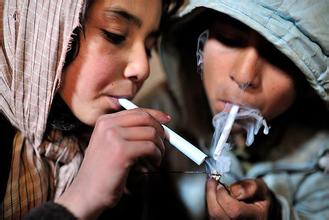亚洲:阿富汗,毒品新高
As violence surges in Afghanistan, so too does the country's opium business.
随着暴力事件在阿富汗剧增,这里的鸦片生意也蒸蒸日上。
Last year was the deadliest year ever for non-combatants, with nearly 3,700 killed.
去年那些不上战场的人中有将近3700人因此丧生,死亡人数空前。
In its latest World Drug Report, the UN says it was also a record year for the area of farmland used to grow opium: 224,000 hectares, which produced 85% of the world's opium and 77% of its heroin.
在最近世界毒品报告中,联合国称用于种植鸦片的农田面积达到新高:224000公顷的土地提供了世界上85%的鸦片和77%的海洛因。

When cocaine production was at its peak in Colombia in the 1980s, drugs produced 6% of that country's income.
在20世纪80年代可卡因在哥伦比亚泛滥成灾时,毒品竟然占到国民收入的6%。
In Afghanistan, they generate at least 15%.
在阿富汗,至少占到15%。
The business thrives on the lawlessness of conflict, which has escalated in Afghanistan along with the withdrawal of a large part of the American-led international forces.
这个生意之所以红火是因为在打击中无法可依,加上美国主导的国际刑警组织撤退造成在阿富汗地区斗争不断升级。
Large-scale poppy-growers often use their connections to keep prying officials at bay.
大规模的罂粟种植者经常利用关系使卧底警察陷入困境。
Eradication efforts thus mainly target poorer farmers.
这样一来贫穷农民主要是根除力量的打击对象。
That risks making the violence worse.
这种风险让暴力不断恶化。
Desperate farmers stripped of their livelihoods may turn to the Taliban.
使得温饱不济而又绝望的农民可能转而投身塔利班。



